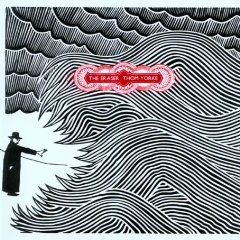 This morning I was listening to Thom Yorke’s solo record, The Eraser, and it reminded me of something I noticed when I first heard it a couple years ago. I don’t know if I’ll be able to communicate this well in print, but I’ll try…
This morning I was listening to Thom Yorke’s solo record, The Eraser, and it reminded me of something I noticed when I first heard it a couple years ago. I don’t know if I’ll be able to communicate this well in print, but I’ll try…
Each and every track on this album has a rhythmic “bait-and-switch” happening in it. What I mean is: the groove, when it starts, gives the impression that the downbeat is in a different location than it really is. Each song begins by hinting at a groove that doesn’t actually exist, and then the reveal happens at various points depending on the song. Some of the tracks develop almost immediately so that the REAL downbeat shows itself, while other tracks are able to maintain the ambiguity for quite a while (until the syncing of a vocal melody and a chord change make the real groove impossible to miss). In each tune, there’s a moment where my head “shifts” from my misinterpretation of the groove to the true groove.
It’s like when you’re driving in the car listening to the radio, but it’s not too loud, and you hear the sub-harmonics of the bass, and they make you think the song is in a different key than it really is… so you turn the radio up to sing along with it, and you realize that you’re singing along in a totally different key than the actual song. Maybe nobody can relate to that analogy, but that’s always the feeling I have when listening to each track on The Eraser.
The totally rad part about this, to me, is that I’m a drummer. I play and teach rhythm for a living, and Yorke gets me every time with this groove trickery! I love it. His patterns are cool from both perspectives, but only one of them is the “real” groove for the track. I have to assume that he’s aware of the deceptive nature of his programming, and I can probably also assume that he’s doing it intentionally, especially in light of this lyric, buried in the middle of Black Swan (track 5): “This is your blind spot… it should be obvious, but it’s not.”
It’s as if Yorke, as the performer/composer, doesn’t want to let the listener in on the perspective that he has on the track until he’s good and ready. In most/all other circumstances, a recorded piece of music leaves the performer/composer on an even playing field with the listener. The performer/composer no longer has exclusive rights to the sounds he/she is imagining – now anyone can just listen to the recording and hear the same thing the performer/composer hears. But Yorke, in pulling this “bait-and-switch” with the grooves on his tunes, still manages to have 10 seconds (or even 2 minutes) in each track where he’s the only one who knows what the true sound of the song is, while presumably everyone else is getting duped by the displaced downbeat. This concept is FANTASTICALLY interesting to me.
Needless to say… The Eraser is a brilliant album.

4 comments
Comments feed for this article
February 16, 2009 at 1:18 pm
JoeS
I have run into a similar issue with two songs in my collection. The piano intro to “Take Away” by Mainstay is very similar to the intro to “The Highest and Greatest” by Tim Hughes, except Mainstay’s song is in 4/4 and Hughes’ is in 6/8. But when I hear “The Highest and Greatest” I can’t find the downbeat until the whole band comes in. It throws me 90% of the time.
February 16, 2009 at 2:05 pm
Erik
Steve, I absolutely *love* when I find albums/tracks that do this. It’s humbling in a way – we like to think that we have things figured out, but then a track like this comes along and puts us back in our place.
I don’t have York’s album yet, but I’ll be sure to add it to my “to-buy” list.
One track in my library that really did this to me the first time or two I listened is “Spam-Boo-Limbo” by the Esbjorn Svensson Trio. It’s on their “Good Morning Susie Soho” album – might you have that in your library?
February 18, 2009 at 8:42 am
NateStromberg
Well said Steve…. After I saw the movie “The Prestige”, which has “Analyze” at the credits, I picked up this album and was absolutly stumped. It takes me about half that tune to tell that the groove is different, and I’ve listened to it over and over and every time it interests me. Hows about Radiohead on that Grammys?
February 19, 2009 at 9:57 am
tomatobrown
Steve Reich